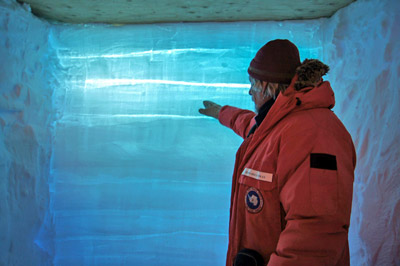
Climate Change - Facts - An Overview
Climate change is leading to global warming, the heating of the planet above the temperature it is expected to be from the recent past. It is such a concern at the moment as the temperature is rising at a rate far faster than ever before and it is the activities of the human population over the last 150 years or so that is causing it.
Connected pages: Antarctica and climate change | climate change misconceptions | save the poles from climate change
What Is Climate Change And Global Warming?
The temperature records used to calculate the extent of climate change are extensive, they have been assembled from thousands of observation sites on land and sea covering a large, representative portion of the Earth's surface over many decades. Checks and allowances have been made for any bias that may have arisen from the weather stations or instrument changes.
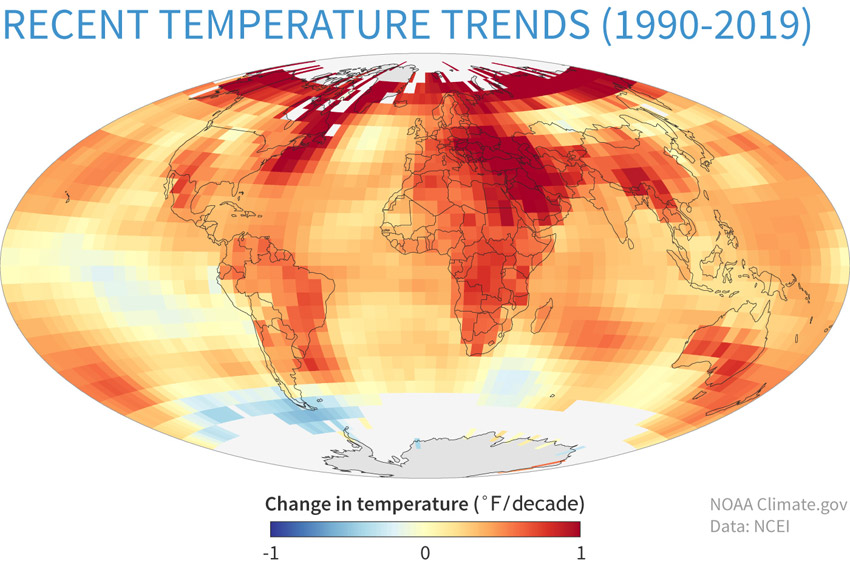
The current rate of change is much faster than at any other time in the last 1,300 years and this is a real problem as the human population of the earth is dependent on a stable climate for established settlements such as citifies and towns agriculture, animals and plants can adapt to slow changes by migration for instance, though a rapid change will inevitably lead to large extinctions of many species. While the planet's temperature changes and always has done so, slowly over periods of tens and hundreds of thousands of years and certainly over millions of years, we don't know exactly what will happen with relatively rapid changes in temperature.
Global temperature rises are affecting the Polar ice-caps, melting is adding to global sea level rise that could potentially be measured in meters. There are a great many cities around the world that are built on the coast or on the banks of low-lying major rivers and they would be flooded and perhaps have to be abandoned at least in part. There are also many countries, especially poorer countries where a large part of the population live in coastal regions. In this case the farm-land would be flooded and the people left homeless and without the ability to feed themselves. In some cases entire island nations (albeit small ones) in the Pacific Ocean could simply disappear.
Climate changes in the past over Geological time periods (hundreds of thousands of years upwards) have been very drastic. During cold periods, much of the planet, even thousands of miles from both poles have been ice-covered by huge glaciers. During warm periods, the same regions may have been sub-tropical or even tropical. Accompanying this have been large changes in sea-level so that some areas of land have either become flooded completely or left high and dry. All of these events have been very slow, in geological terms a "rapid" event still takes thousands of years, it is the current RATE of change that is of concern.
There are two aspects of Climate Change that the world needs to address at the moment and neither has clear answers, there is much scientific debate and an awful lot of political argument though as time has gone on we are becoming more certain about what is happening and what to do about it, much more so than ten or twenty years ago.
- How do we stop it?
- Whose responsibility is it to stop it?
- Can we stop it?
- How do we deal with it's effects?
1/ If Global Warming is the result of man's activities:
2/ As Global Warming is taking place, regardless of the cause:
How Do We Know That Global Warming Has Taken Place?
We know that global warming has taken place because millions of temperature measurements have been taken over many decades from all points on the earth. In Antarctica, some of the first measurements were made on Captain Scott's expeditions in the early 1900's. The measurement of global warming is by a wide variety of statistics over a long period of time and can be quite difficult to explain and understand.
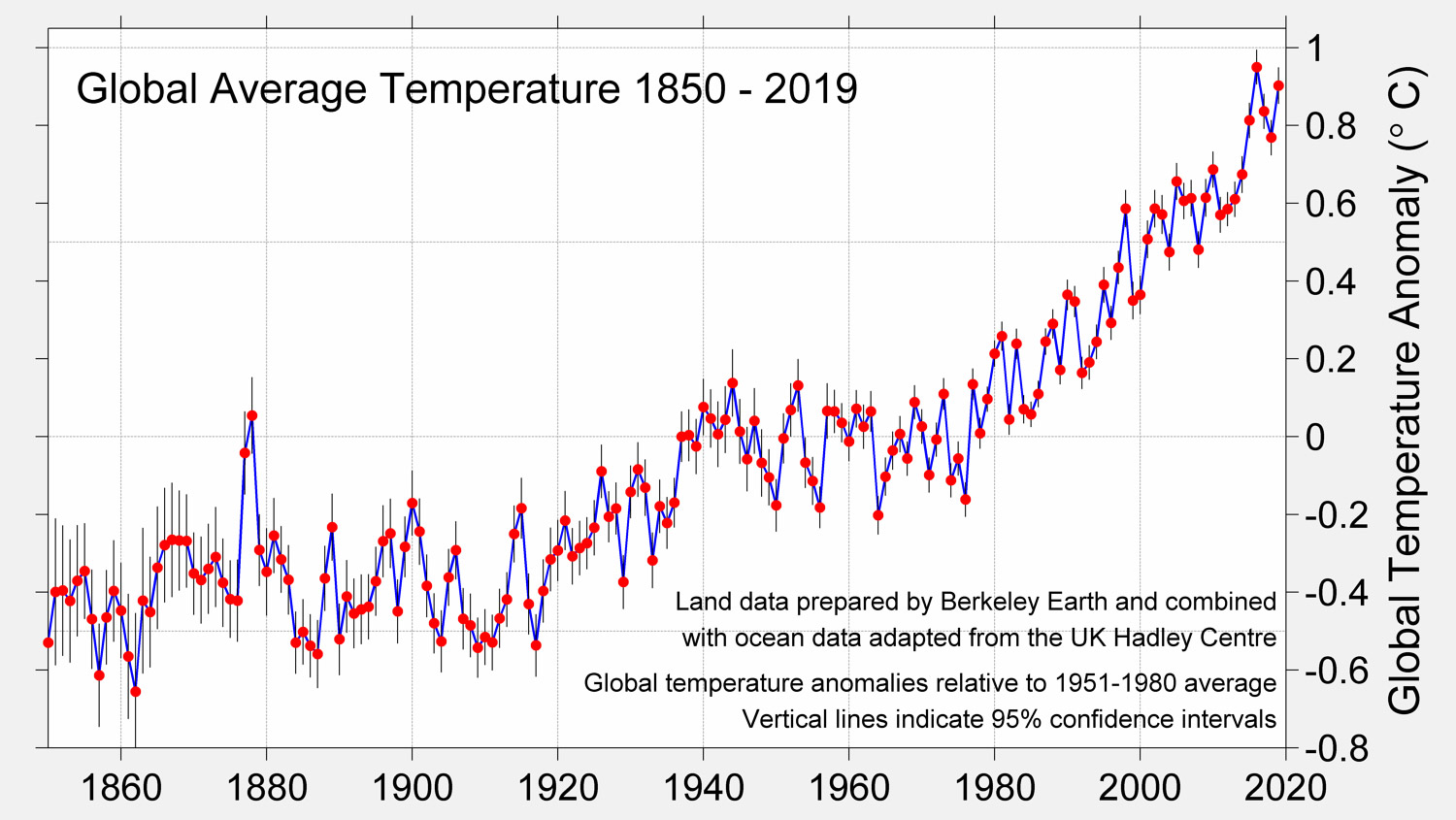
The global average
air temperature shows an increase 0.08 C per decade from 1880-1980,
increasing to more than double this at 0.18 C per decade from
1980-2020 for a current total global average increase of about
1 C.
Past record years have come pretty much at random and certainly not in groups. The ten hottest years in Britain since accurate records began to be recorded in 1884 have all occurred since 2002, globally the hottest ten years have been since 2009 and the hottest six since 2015, with 2016, 2019 and 2020 being the top three.
Daily variations in temperature can commonly be from 5C to 10C which makes the average 1C rise difficult to spot by the individual in the shorter term.
Some parts of the world are showing the effects of warming more than others. The Northern hemisphere appears to be warming more than the Southern hemisphere, possibly because there is more land in the north and more sea in the south
How Does Global Warming Affect Our Lives Now?
Until recently (the last 5-10 years or so) it was difficult to say specifically what the current effects of global warming were as the weather over much of the globe is subject to large natural variations.
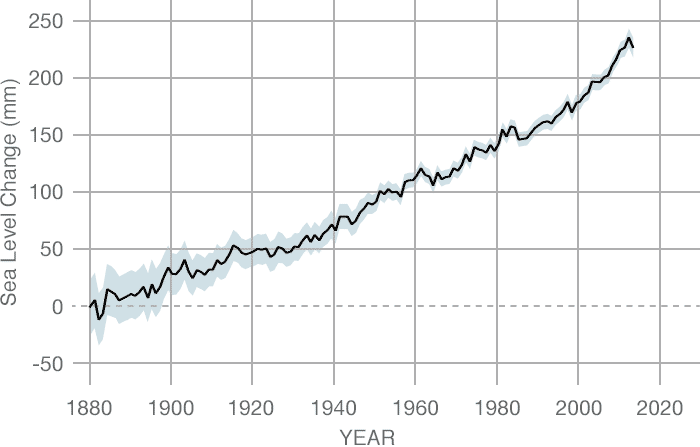
As time has gone on however, it has become increasingly more certain that some specific events such as an extreme warm spell, a storm, flood etc. are as bad as they are a result of climate change. While these things have always happened and have always varied in intensity and frequency from year to year, climate change can increase the extreme nature of natural destructive events in both intensity and frequency.
These are some of the effects of climate change that have been observed:
-
The ranges of plant and animal species are shifting towards the poles at around six kilometres a decade.
- This will affect which crops can be successfully grown in a particular region. -
Sea levels have risen around the world by around 200mm (8 inches) in 150 years as a result of increased meltwater from ice-caps but mainly from the thermal expansion of sea water.
- Threats to coastal settlements and low-lying areas from storms and flooding. -
The frequency of heavy precipitation events (rainfall) has increased over most land areas, especially in eastern parts of North and South America, northern Europe and northern and central Asia.
- Greater prevalence of floods, especially flash-floods following intense rainfall. -
Drying in the Sahel, the Mediterranean, southern Africa and parts of southern Asia.
- Resulting in crop failures and increased regional conflict. -
More intense and longer droughts observed since the 1970s, particularly in the tropics and subtropics.
- Crop failures, regional conflict and displacement of peoples. -
Annual average Arctic sea ice extent has shrunk by 13.1 % per decade in the summer and 2.6 % in winter over the last 40 years.
- Effects on wildlife, particularly polar bears at first. -
Melting permafrost, temperatures at the top of permafrost layer have generally increased since the 1980s by up to 3C
- Buildings and roads subside and ecosystems are altered across the arctic from Alaska to Canada and Russia. -
Cold days, cold nights and frost less frequent.
- Changes to local ecosystems, potential imbalances between hosts, pests and diseases. -
Hot days, hot nights, and heat waves more frequent.
- More heat related deaths. -
An increase of intense tropical cyclone activity in the North Atlantic since about 1970, correlated with increases of tropical sea surface temperatures.
-
Retreat of glaciers and snow pack in mountainous regions
- Such areas act as slow-release reservoirs for water supply in many parts of the world - can lead to water shortages, droughts and floods.

Glacier retreat since 1960
These aspects of climate have not been observed to change so far:
-
Increased incidence of Tornadoes
-
Increased incidence of Dust-storms
-
Increased incidence of Hail
-
Increased incidence of Lightning
-
Melting Antarctic sea ice
How Might Climate Change Affect Our Ffuture?
The predicted effects of global warming are starting to happen in that more of what would have been "normal" storms are becoming more destructive, heavy rainfall becomes very heavy rainfall becomes a flash flood, short droughts become longer droughts etc. The warming caused by climate change is putting more energy into the atmosphere which is manifesting as more destructively energetic weather.
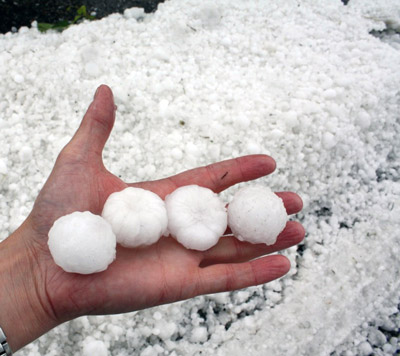
More extreme weather events will become more common.
The worst potential effects of global warming are probably a result of melting of icecaps so causing global sea-levels to rise and flood many low-lying areas of the world including major cities and agricultural areas. The extent to which this might happen is dependent on how much the temperature may rise and this is the most difficult to forecast.
Current estimates for the amount of warming over the next century range from 1.4 to 5.5C (2.5 - 10 F) - this is in addition to warming that has already happened. The IPCC predicts that if the global mean temperature can be kept to within 1 to 3C (1.8 - 5.4 F) above 1990 levels the negative overall impacts in some regions will be balanced by positive ones in others, above this level the net effect is negative and rises as temperature rises. This of course doesn't take into account that those people living in the negatively affected regions will not see much if any of the positive effects.
Future warming effect is expected to be greater in the Northern than the Southern hemisphere and to become more pronounced at higher northern latitudes.
These are some of the predicted effects for the future:
-
Changes in the pattern of rainfall, some regions becoming wetter, other drier, an increase of heavy rainfall events that has already started will continue.
-
More drought and heat waves, greater frequency and intensity. Less frequent and intense cold weather events.
-
Wildfires will become more frequent and affect more areas as vegetation dries out, including regions little or not currently prone to such fires.
-
Sea levels will rise another 30 to 240 cm (1-8 feet) by 2100, they have already risen about 20 cm (8 inches) since 1880, this is from thermal expansion of the oceans and addition from melting land ice.
-
Arctic late-summer sea ice disappears almost entirely by the mid 21st century.
-
Likely that future tropical cyclones will become more intense, with larger peak wind speeds and more heavy precipitation.
-
Anthropogenic warming and sea level rise would continue for centuries due to the timescales associated with climate processes and feedbacks, even if greenhouse gas concentrations were to be stabilized.
-
Temperatures in excess of 1.9 to 4.6C warmer than pre-industrial levels sustained for millennia - eventual melt of the Greenland ice sheet. Would raise sea level by 7m. Comparable to 125,000 years ago.
-
Snow cover is projected to contract.
Picture credits, copyright pictures used by permission: Graphs used courtesy NASA / Hailstones - Matthias Binder, Skywarn Austria
